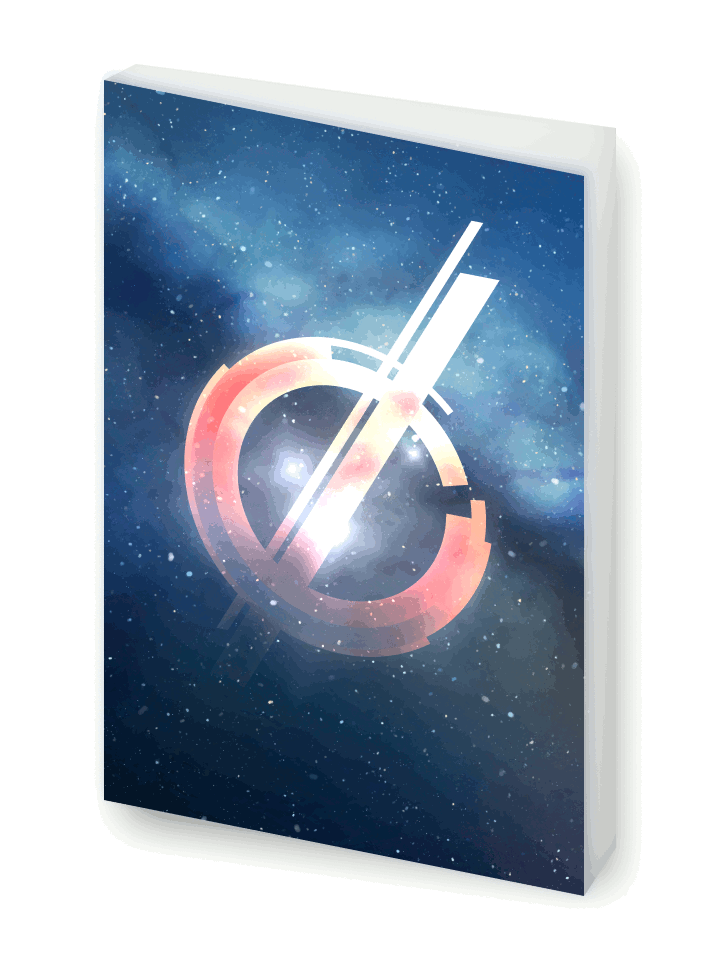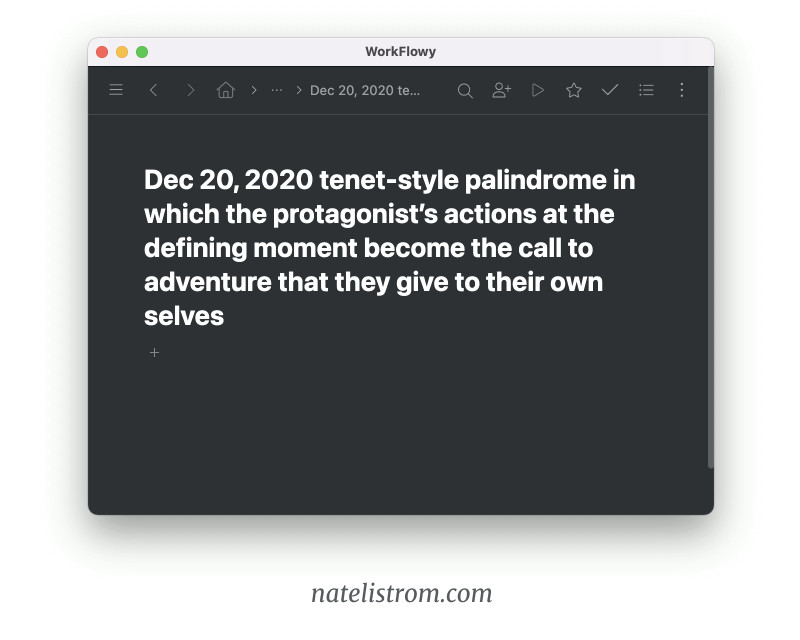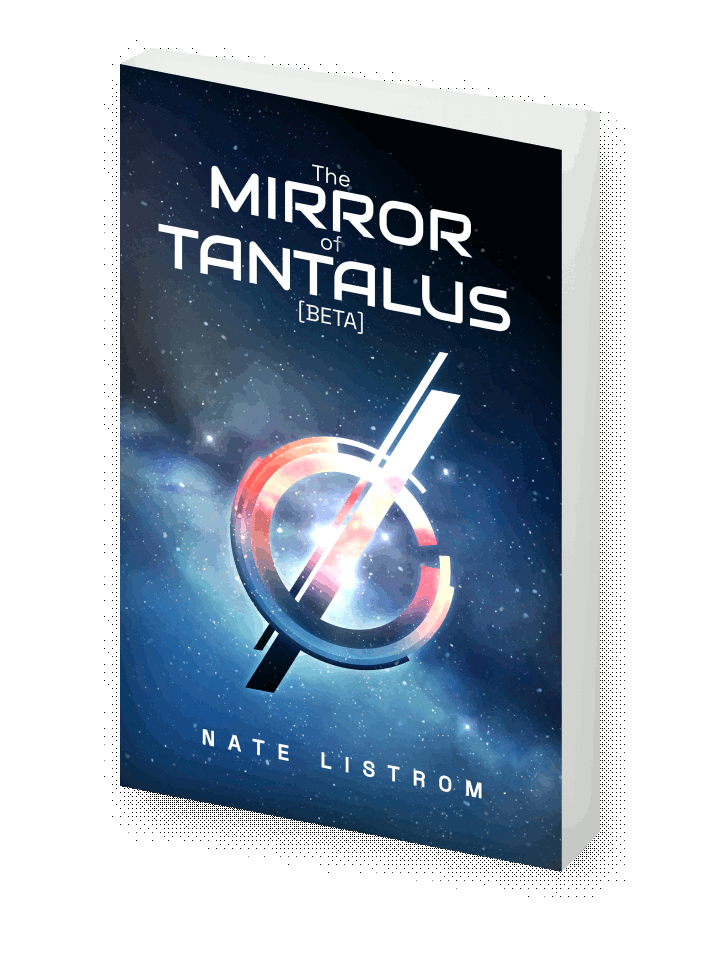Beginnings: The making of ‘The Mirror of Tantalus’ (part one)
Summary: The story of how I conceived of the premise for my novelette, ‘The Mirror of Tantalus’ and how connecting with a coworker encouraged me to write the story

I love listening to artists talk about how they developed their work. You can learn so much from the chronicle of the ups and downs, the false starts and dead-ends, the discoveries made along the way. So, here’s the first note in a little “making of” series about the development of my novelette, The Mirror of Tantalus.
I hope this window into the process is useful to you, dear reader, as you work on your own projects.
An idea for an experiment (Dec 2020 - Apr 2023)
Tantalus started in December of 2020 as an idea for an experiment.
I’d been toying around with K. M. Weiland’s claim that the major beats of a plot mirror one another around the midpoint, and I wanted to see if I could demonstrate the theory by building a new story using that structure.
Normally, the resonance of major plot movements emerges organically and only becomes visible in hindsight. I wanted to flip that process and construct the plot with that resonance in mind from the start.
My core premise was that I wanted the protagonist’s own action in the climactic moment to be the thing that spurred her to set out on the journey in the first place. Somehow, she needed to give herself her own call to adventure.

Once that constraint was in place, I knew I was working with a time travel story.
At that point, I had only a vague notion of what the story would be. Mostly, it was just a sense of the feeling I wanted to convey, something having to do with loneliness, perhaps a bit of wistfulness, and an uncanny mystery in which things were happening that defied easy explanation.
Space became the setting for the story almost from its inception. The time dilation effects from Christopher Nolan’s Interstellar had fascinated me when I saw the film, and I figured I could use gravity as a sort of pseudo-scientific explanation for the time travel elements in my own story. A
In order to connect the protagonist at the climax with her earlier self at the call to adventure, I came up with the notion that she would be sending messages back to her earlier self. In the first half of the story, she would be discovering the messages and then, once she reversed directions, she’d be writing them.
This created some interesting possibilities. I had a picture in my mind of handwritten letters sort of “un-writing” themselves. (The disappearing people in the photos in Back to The Future come to mind.)
Through most of the next two years, the story sat percolating on the back burner. This happens to many of my story ideas. They stay in this mode for a while, marinating. When a thought comes to me, I’ll write it down, adding it to an ever-growing pile of notes. Then, eventually, something happens that motivates me to take all those notes and start shaping them into a story.
First draft (Mar - Apr 2023)
Around March and April of 2023, I blocked out an outline for the major structural beats. I’ve always been more of a “plotter” than a “pantser.” If I don’t know where the story is going next, I tend to get bogged down in indecision. For this project, in which I was trying to build a specific structural shape, outlining felt especially appropriate.

Once I had the shape of the story, I started a first draft. I wrote a lot of the prose directly in WorkFlowy, my go-to outlining and note-taking tool. I already had my story development notes in the tool, and using WorkFlowy allowed me to easily capture, expand and collapse, and move around elements as I was exploring the story and trying to figure out what it was and what it wanted to be.
As I began to write out the draft, I realized I’d created a problem for myself.
In the two years that the story idea lay dormant in my notes, my concept had been that the protagonist would leave hand-written messages for herself. But as I started to get into seriously considering the story, I realized that wouldn’t work.
It was crucially important that the protagonist never see her reversed self. That would spoil the mystery of the time reversal, and I wanted the protagonist and the audience to only begin to understand what was happening quite late in the story.
How could the protagonist inhabit the same spaces as her forward-facing self and yet not be discovered? I toyed with the idea of making her reversed self invisible, but the science didn’t add up. B
In the end, I arrived on a different solution. Rather than both being in the same spaces, her forward and reversed selves would be in different spatial locations. This could easily be explained by the ship’s motion toward Tantalus. Thus, it would never be as though she and her mirrored self were inhabiting the same room, in the same location in space, at the same moment.
This solved the problem with her seeing herself but it created a new one. If she were in different locations in space, she wouldn’t be able to send herself the written messages.
What she and the others could do was observe the other version of the ship from the outside. That led to the idea of using Morse code, a way for the messages to be sent backward without the crew realizing what was happening until the second half of the story.
With that, I had something I could work with.
Life got busy, and after I got the rough story down, I put the project on hold.
A little push to begin (Jan 2024)
Tantalus would probably still be just that set of scribbled notes and a loose rough draft if it were not for a coworker of mine.
One of the many pleasures I have in my job is that I get to research interesting topics and present about them to my coworkers. One of my talks was about storytelling.
After the talk, a few coworkers connected with me. I was expecting them to be interested in the business applications of storytelling, but to my surprise, some wanted to talk about fiction. (I work with a lot of creatives, and many of us have side projects.)
So, this coworker and I met. We talked about our interest in the craft and our various writing projects. She’s written more than I have and has even published a couple of wonderful short stories. I read and quite enjoyed them (and I think you will too).
I came away from the conversation feeling encouraged to get back into fiction writing. Specifically, I wanted to take something far enough to publish, which I hadn’t yet done.
I knew I didn’t have time for a new novel-length piece, and I didn’t have the confidence to go back and re-work the broken novel that I’d already written. I needed something smaller and more manageable, and my little abandoned draft for Tantalus seemed like a good place to start . . .
I’ll leave things here for now. In the next note, we’ll look at the drafting phase.
Onward!
You (yes, you!) can help
I need your feedback to make the story better.
First, read The Mirror of Tantalus
The Mirror of Tantalus (Beta)
17K words | 2hr reading timeWhen a strange interstellar object enters Earth’s system, Charis Samogost joins an unlikely alliance of nations sent to investigate. As they draw nearer to their goal, loyalties are tested, and Charis must decide what’s most important to her . . . and what she’s willing to do to get it.
After that, fill out a 5 min feedback form →
. . . And thank you for being here and catching up with my little journey.
Rate this note
Read this next
Drafting: The making of 'The Mirror of Tantalus' (part two)
The tools and process I used to write the second draft of my novelette, 'The Mirror of Tantalus' and some examples of the revisions I made at that stage of the story's development
Get free updates
Thoughtful insights on storytelling, published the first Tuesday of each month.
